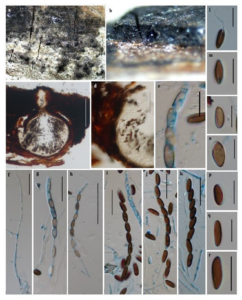Anthostomella elipsoidea M. Niranjan.M and V.V. Sarma
Indexfungorum number: IF 558368; Facesoffungi number: FoF 09813
Etymology – In reference to the presence of ellipsoidal ascospores.
Saprobic on decaying twigs. Sexual morph: Ascostromata strong, thick stromata covering the surface of pseudostromata. Ascomata 420–510 × 380–400 µm, perithecial, subglobose to globose, ostiolate, immersed, single to a group within the stroma, clypeate, bipartite. Hamathecium: paraphyses long, septate, un-branched, longer than asci. Asci 80–118 × 4.5–6.2 µm (x̄ = 96 × 5.0 µm, n = 20), 8-spored, unitunicate, uni-seriate, cylindrical, with a non-amyloid apical ring. Ascospores 7.5–12.5 × 3.7–5 µm (x̄ = 9.7 × 4 µm, n = 20), hyaline when young, sub-hyaline to grey at maturity, aseptate, ellipsoid, rounded ends, with a straight germ slit, lacks mucilaginous sheaths. Asexual morph: Undetermined.
Material examined – India, Andaman and Nicobar Islands, South Andaman, Ferrargunj, (11˚38’34.2” N 92˚42’23.1” E). Recorded on decaying twigs, 10 August 2016, M. Niranjan & V.V.Sarma (PUFNI 16335).
Additional specimens examined – South Andaman, Port Blair, Chidiya Tapu, Viewpoint (11˚28’50” N 92˚42’38” E) on an unidentified twig (T84F1) 30 May, 2017; Manjery (11°85’91″N 92°73’75″E) on an unidentified twig (T130F1), 8 December 2017; Port Blair, Chidiya Tapu, Viewpoint (11˚30’48” N 92˚42’36” E) on Diospyros marmarata (T424F2) 20 May 2018.
Notes − Anthostomella consists of more than 100 species (Wijayawardene et al. 2017). Daranagama et al. (2016) provide a key to other closely related genera. The taxa belonging to Anthostomella have immersed ascomata, cylindrical asci with apical rings, and brown ascospores with a germ slit. A. elipsoidea has thickened stromata associated with host tissues and ascomata immersed in the stromata. The other genera have the following characteristics which separate them from Anthostomella: while Anthostomelloids has oblong-ellipsoidal ascospores lacking germ slits; Pseudoanthostomella has solitary ascomata lacking a central periphysate ostiolar canal; Neoanthostomella lacks apical rings in asci; Alloanthostomella produces only hyaline ascospores (Darangama et al., 2016). Based on the presence of immersed ascomata in a pseudostroma and ellipsoidal ascospores with a straight germ slit, the new species is placed in the genus Anthostomella. The present taxon is single-celled, while many species of Anthostomella have a smaller basal cell. Also, while several species of Anthostomella have mucilaginous sheaths around the ascospores, the present taxon lacks mucilaginous sheaths. The single-celled Anthostomella such as A. conorum, A. oblongata, A. helicofissa, A. obesa, (Lu & Hyde 2000; Lee & Crous 2003; Daranagama et al. 2015).
Figs 1. Anthostomella elipsoidea (PUFNI 16335) a, b Ascostromata on twigs c Vertical section of Ascomata d Peridium e Apical thickening f Paraphyses g–k Asci l–r Ascospores. Scale bars c=200µm d=50 µm f, g–k= 20 µm e, l–r=10 µm.

